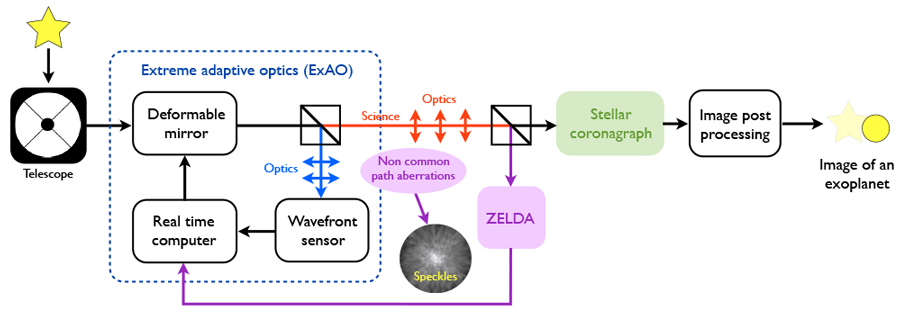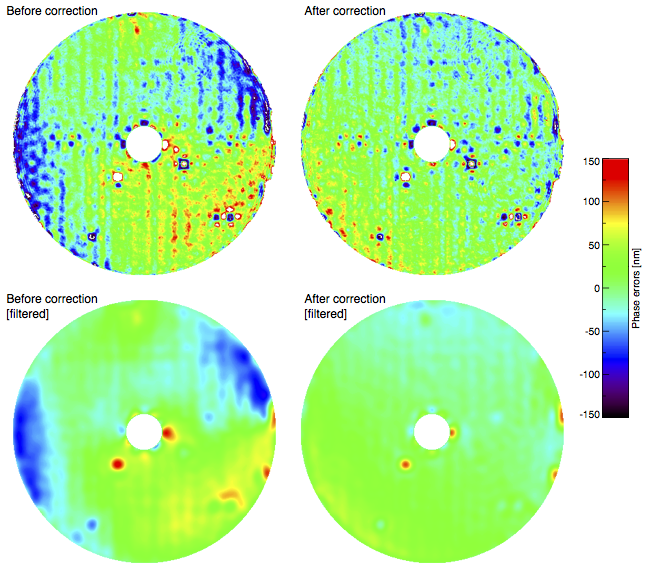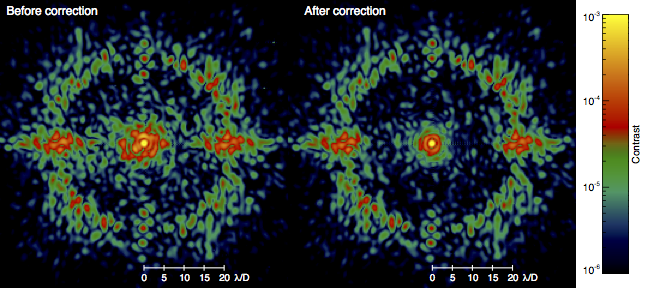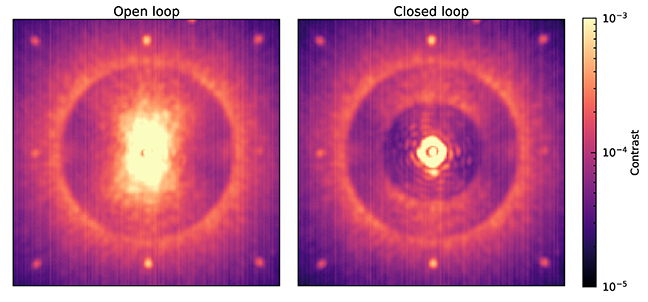ZELDA
ZELDA is a Zernike wavefront sensor designed to measure low-levels of instrumental aberrations in near-diffraction limited high-contrast imaging instruments. The concept has been implemented and validated in VLT/SPHERE, where is is now used to monitor the temporal evolution of the aberrations of the instrument. A public analysis code, pyZELDA, is available on GiHub.
Context and goals
High-contrast imaging of exoplanets on large telescopes requires extremely low-levels of instrumental aberrations to reach the highest possible rejection of the diffracted stellar light using a coronagraph and to minimize the residual speckles in the focal plane. These speckles are the main limitation when it comes to the detection of faint, self-luminous planets at angular separation a fraction of an arc-second. To reduce the level of quasi-static speckles, it is necessary to minimize the instrumental aberrations, e.g. by measuring them with a wavefront sensor and compensating them with a high-order deformable mirror. However, any extreme AO system (ExAO) will be intrinsically limited by the differential aberrations between the sensing path and the science path (e.g. Fusco et al. 2006). These so-called non-common path aberrations (NCPA), and their temporal variation over timescales from a few seconds to several hours, result in a degradation of the wavefront downstream of the ExAO, which will limit the ability to detect faint planets in the focal plane (Soummer 2007).

ZELDA (Zernike sensor for Extremely Low-level Differential Aberrations) is a Zernike wavefront sensor designed to measure low-levels of NCPA with sub-nanometric accuracy in near-diffraction limited optical systems (N'Diaye et al. 2013). It uses a simple pinhole phase mask in the focal plane, with a diameter approximately equal to the diffraction limit of the system and a dephasing of π/2. The interference between the part of the wave dephased by the pinhole and the part not dephased will transform phase aberrations into intensity variation in the relayed pupil plane. In the small-phase regime, there is a linear relationship between the intensity in the pupil plane and the phase aberrations, which enables to reconstruct the aberrations of the system.
Validation in SPHERE
A prototype of ZELDA has been installed in VLT/SPHERE in 2014 to provide a diagnostic tool as well as an alternative means of calibrating the aberrations of the instrument. In principle, using ZELDA to calibrate the NCPA is straightforward:
- Measure the NCPA with ZELDA
- Filter the reconstructed aberrations by what the deformable mirror can correct
- Apply the inverse of the aberrations as an offset on the deformable mirror
In 2015, we obtained data in VLT/SPHERE on the internal source to test and optimize this sequence, and validate the performance of the ZELDA sensor for the calibration and compensation of the NCPA (N'Diaye, Vigan et al. 2016). As illustrated below, the validation was completely successful: we managed to decrease the amount of NCPA by a factor of more than 2, falling under 20 nm RMS of internal aberrations in the range of spatial frequencies that the SPHERE deformable mirror can correct.

The result of the NCPA compensation is perfectly visible in coronagraphic images acquired on the internal point source. The correction enables visibly decreasing the amount of speckles within the correction radius of the ExAO system, and particularly at close separation from the coronagraph (3-6 λ/D), which is where we desperately need to improve the performance to detect more planets. The gain measured at 0.1" is of the order of a factor 15.

On-sky compensation
ZELDA is now used every day to monitor the internal aberrations of SPHERE, but the next step is to use this correction of the NCPA on-sky to improve the detection capabilities of the instrument. The on-sky validation of the NCPA correction has been demonstrated in 2018 with SPHERE. We showed that a small gain in raw contrast is obtained (see plot below), but the gain is in fact ultimately limited by the current design of the SPHERE APLC. A different coronagraph design and an improved control of the NCPA is now foreseen for the SPHERE upgrade project, SPHERE+, recently proposed to ESO.

Temporal evolution
Finally, our most recent work, we used ZELDA to monitor the variation of aberrations over timescales of several hours to understand the limits of SPHERE. We identified the presence of internal turbulence caused by the warming of a motor, which currently sets the fundamental limit to the contrast in SPHERE. When subtracting this spurious contribution, we demonstrated a slow decorrelation of the aberrations with time, which results in a loss of contrast (see plot below). Although this decorrelation was known from previous focal-plane measurements, this is the first time that we obtain an estimation directly quantified as a wavefront error. This provides valuable inputs for ongoing upgrade projects for SPHERE.

On-going and future work
Segmented telescope phasing
The cophasing of segmented telescopes at very high-accuracy is an important problematic for high-contrast imaging on Extremely Large Telescopes (ELTs) or future space-based observatories like LUVOIR. We have already demonstrated the power of a seeing-limited Zernike wavefront sensor for segment phasing with the instrument ZEUS (Dohlen et al. 2006; Surdej et al. 2010; Vigan et al. 2011), which was developed at LAM and validated in the Active Phasing Experiment (APE, Gonté et al. 2006). Further work in this direction was done at ESO with an upgraded version of the APE bench (Cheffot et al. 2020).
For very high-contrast imaging applications, simulations (Janin-Potiron et al. 2017) and laboratory experiments (Pourcelot et al. 2021) have explored the use of a Zernike wavefront sensor for extremely accurate phasing (see image below), as well as for the compensation of low-order aberrations (Pourcelot et al. 2022; 2023).

Second-stage AO with a ZWFS
Finally, we are now exploring the use of a ZWFS as the sensor for a second-stage AO system as a replacement for a pyramid. This is explored very generally but could have direct applications in the ongoing upgrade of the SPHERE ExAO system. The first results obtained on the GHOST test-bed at ESO are very promising and will be presented in detail in a forthcoming publication (N'Diaye, Vigan et al.).
Collaborators
Main collaborators: Mamadou N'Diaye, Kjetil Dohlen.
Other collaborators: Jean-Luc Beuzit, Byron Engler, Thierry Fusco, Markus Kasper, Patrice Martinez, Julien Milli, David Mouillet, Jean-François Sauvage, Zahed Wahhaj, Gérard Zins.
Publications
- Low-order wavefront control using a Zernike sensor through Lyot coronagraphs for exoplanet imaging. II. Concurrent operation with stroke minimization
- 2023, A&A, 672, A73
- Low-order wavefront control using a Zernike sensor through Lyot coronagraphs for exoplanet imaging. Blind stabilization of an image dark hole
- 2022, A&A, 663, A49
- Calibration of quasi-static aberrations in exoplanet direct-imaging instruments with a Zernike phase-mask sensor. IV. Temporal stability of non-common path aberrations in VLT/SPHERE
- 2022, A&A, 660, A140
- Calibration of residual aberrations in exoplanet imagers with large numbers of degrees of freedom
- 2021, A&A, 649, A170
- Measuring the cophasing state of a segmented mirror with a wavelength sweep and a Zernike phase contrast sensor
- 2020, Optics Express, 28, 12566
- Calibration of quasi-static aberrations in exoplanet direct-imaging instruments with a Zernike phase-mask sensor. III. On-sky validation in VLT/SPHERE
- 2019, A&A, 629, A11
- On-sky compensation of non-common path aberrations with the ZELDA wavefront sensor in VLT/SPHERE
- 2018, arXiv, 1806.06158
- On-sky compensation of non-common path aberrations with the ZELDA wavefront sensor in VLT/SPHERE
- 2018, SPIE, 10703
- Fine cophasing of segmented aperture telescopes with ZELDA, a Zernike wavefront sensor in the diffraction-limited regime
- 2017, A&A, 603, A23
- Calibration of quasi-static aberrations in exoplanet direct-imaging instruments with a Zernike phase-mask sensor. II. Concept validation with ZELDA on VLT/SPHERE
- 2016, A&A, 592, A79
- ZELDA, a Zernike wavefront sensor for the fine measurement of quasi-static aberrations in coronagraphic systems: concept studies and results with VLT/SPHERE
- 2016, SPIE, 9909
- Design optimization and lab demonstration of ZELDA: a Zernike sensor for near-coronagraph quasi-static measurements
- 2014, SPIE, 9148
- On-sky multiwavelength phasing of segmented telescopes with the Zernike phase contrast sensor
- 2011, Applied Optics, 50, 2708